MTR & AIRPORT EXPRESS, INTER-CITY AND HIGH-SPEED TRAINS
All train services in Hong Kong are operated exclusively by MTR Corporation Limited (MTRCL), since the merger of MTR and KCR (Kowloon-Canton Railway) in December 2007. MTRCL also took over the Intercity cross-border through services to Guangzhou, Shanghai and Beijing formerly operated by KCR at the same time. During a five week period following the merger date all KCR signage and logos at KCR stations were replaced with MTR branding and final integration of the systems was completed by the end of September 2008. Under a 50-year agreement MTRCL pays Kowloon Canton Railway Corporation (KCRC) a fixed amount of HK$750 million annually plus a variable amount based on revenue in excess of HK$2.5 billion for operation of services and use of KCRC's rail assets. The Intercity cross-border service has, however, been suspended since January 2020 owing to the Covid-19 pandemic and MTR has indicated the service may be terminated permanently since passengers numbers have declined substantially since commencement of Express Rail high-speed service. The service concession for the Guangzhou - Shenzhen - Hong Kong Express Rail Link (XRL), which commenced service 23rd September 2018, has been granted to MTRCL for a 10-year period with fare revenue being shared with China Railway Corporation (CRC) according to distance travelled. Land and assets for XRL have been transferred by the Hong Kong Government to KCRC and MTRCL will make service concession payments to KCRC according to actual patronage.
Services can be categorised as;
MTR TRAIN SERVICES ("Heavy Rail")
AIRPORT EXPRESS
MTR LIGHT RAIL
MTR INTERCITY PASSENGER SERVICES (KTT) - Permanently suspended since January 2020
HIGH SPEED RAIL GUANGZHOU - SHENZHEN - HONG KONG EXPRESS RAIL LINK (XRL) AND LONG-HAUL SERVICES INCLUDING BEIJING AND SHANGHAI
MTR TRAIN SERVICES
Hong Kong's MTR system opened on October 1st 1979 and initially served just one route serving nine stations between Kwun Tong and Shek Kip Mei. The first cross-harbour route was introduced in 1980 when the Kwun Tong Line was extended to Central. The system has since been expanded considerably and, following opening of the South Island Line in December 2016, opening of the Tuen Ma Line connecting West Rail and the Ma On Shan Line in 2021 and East Rail cross-harbour extension in 2022, the system now comprises eleven interconnected lines covering about 222kms and serving 96 stations extending from Hong Kong Island and Kowloon to Lantau Island and the New Territories. About 3.9 million passenger journeys were made on the MTR network daily in 2021, a substantial reduction from 4.9 million in 2018, mainly due to the social unrest of 2019 and lack of tourists owing to strict entry requirements to Hong Kong during the COVID-19 pandemic. By the end of 2024 average daily passenger patronage had recovered to about 4.71 million.
EXISTING MTR LINES;
ISLAND LINE (serving northern and north-east Hong Kong Island from Kennedy Town to Chai Wan). Average daily patronage (December 2014) - 1,103,600.
SOUTH ISLAND LINE (from Admiralty Station on the north side of Hong Kong Island to South Horizons on south Hong Kong Island via Ocean Park. Line opened 28 December 2016. Estimated average daily patronage - 170,000.
TSUEN WAN LINE (from Central through the heart of Kowloon to Tsuen Wan). Average daily patronage (December 2014) - 1,115,500
TSUEN KWAN O LINE (from North Point on north-east HK Island to Tsuen Kwan O in south-east Kowloon with branches to Po Lam and LOHAS Park. Average daily patronage (December 2014) - 333,700
TUNG CHUNG LINE (from Hong Kong Station via west Kowloon along the northern coast of Lantau Island to Tung Chung). Average daily patronage (December 2014) - 245,900
KWUN TONG LINE (from central Kowloon serving northern, eastern and south east Kowloon). Average daily patronage (December 2014) - 615,300
EAST RAIL (from Admiralty on Hong Kong Island, cross-harbour* via Kowloon and the east New Territories to Lo Wu mainland border station and spur line to Lok Ma Chau mainland border station). Includes the former Kowloon-Canton Railway (KCR) section of line from Hung Hom to Low Wu.*Cross-harbour extension of the line and new Exhibition Centre Station opened 15th May 2022. Average daily patronage (December 2014) - 1,054,800.
TUEN MA LINE. Line fully opened 27th June 2021 connecting Tuen Mun in New Territories West with Wu Kai Sha Station at Ma On Shan in New Territories East via 27 stations including six interchange stations and two new stations at Sung Wong Toi and To Kwa Wan. (Phase 1 opened 14th Feb 2020 linking Tai Wai in New Territories East through Lion Rock to Kai Tak in Kowloon East via Diamond Hill). Incorporates the former MTR (and previously KCR) West Rail Line and Ma On Shan Line.
DISNEYLAND RESORT LINE (a short dedicated branch line from the Tung Chung Line at Sunny Bay to Disneyland Resort Station). Average daily patronage (2010) - 11,000
AIRPORT EXPRESS LINE (serving Hong Kong International Airport, Tsing Yi, Kowloon and Hong Kong Stations).Average daily patronage (December 2024) - 35,800
For the year ended 31st December 2023 MTR announced the following annual passenger patronage:
Domestic service - 1,586 million
Cross - boundary service - 71.5 million
High-Speed Rail - 20.1 million
Airport Express - 10.8 million
Light Rail and Bus - 207.7 million
FORMER LINES;
WEST RAIL LINE (former KCR line from Hung Hom in southern Kowloon via West Kowloon and western New Territories to Tuen Mun). Incorporated into Tuen Ma Line June 2021.
MA ON SHAN LINE (former KCR branch line from East Rail at Tai Wai along the south side of the Shing Mun River Channel serving eastern New Territories New Towns terminating at Wu Kai Sha). Incorporated into Tuen Ma Line Phase 1 February 2020.
RAIL DEVELOPMENT STRATEGY 2014
In September 2014, following a three year study, the Transport and Housing Development Bureau announced its Rail Development Strategy 2014 which sets out a framework for Hong Kong's railway development until 2031. On completion of the recommended schemes the network will include the following additional new lines, extensions and stations;
NORTHERN LINK AND KWU TUNG STATION - a major regional line, approx 10.7km, connecting existing West Rail and East Rail Lines by linking Kam Sheung Road Station on West Rail with a new station at Kwu Tung on the Lok Ma Chau Spur Line. Completion date for the whole scheme advanced from 2036 to 2034 following granting land for residential and commercial development to fund the scheme in July 2025. The scheme to develop the new Kwu Tung Station was gazetted in April 2022 and the Northern Link October 2023. Indicative implementation* 2022 to 2027. Funding HK$9.8 bn approved Sept 2023, government authority to proceed confirmed April 2025. Expected completion 2034. Construction of Kwu Tung Station commenced February 2025, will be topped out during 2026 with completion 2027.
HUNG SHUI KIU STATION - a new intermediate station on West Rail Line between Tin Shui Wai Station and Siu Hong Station. Indicative implementation. Construction authorised by the government 26 March 2024 to commence 2024 with expected completion 2030.
TUNG CHUNG LINE EXTENSION - Comprises two sections, "Tung Chung East (TCE) Section" and "Tung Chung West (TCW) Section". TCE Section includes the construction of the TCE Station at TCE reclamation area between the existing Sunny Bay Station and Tung Chung Station and approximately 1.2 kilometre long railway track re-alignment for the existing Tung Chung Line (TCL). TCE Station is an above-ground station with an elevated concourse. TCW Section is an approximately 1.3 kilometre long westward extension from the existing railway tunnels of Tung Chung Station with the construction of the TCW Station at the west of Yat Tung Estate. TCW Station is an underground station and will become the new terminal station of the Tung Chung Line.The scheme was gazetted by the government in December 2022, project commencement authorised in January 2023, finance agreement between government and MTRCL signed 28th February 2023, construction to commence mid-2023 (ground-breaking ceremony 15th May 2023) with completion expected in 2029. Funding HK$15.8 bn approved Sept 2023. The Airport Railway Extended Overrun Tunnel from the Tung Chung Line Extension is targeted for commencement of construction in 2025 with completion in 2032.
TUEN MUN SOUTH EXTENSION (TUEN MA LINE) - extension of West Rail Line southward from Tuen Mun Station to a new station at Tuen Mun South near Tuen Mun Ferry Pier. The line will additionally include a further new station at Tuen Mun Area 16 development area. HK$6.22 billion contract signed December 2023 with China Road and Bridge Corp and Build King Construction joint venture for 2.4km extension south from Tuen Mun Station. Construction to commence December 2023, completion expected 2030 including new stations in Area 16 and Tuen Mun South.
EAST KOWLOON LINE - originally a new line running from the existing Diamond Hill Station on Kwun Tong Line (and the future Sha Tin to Central Link) originally intended to run to the existing Po Lam Station on Tsueng Kwan O Line with new stations at Choi Wan, Shun Tin, Sau Mau Ping and Po Tat. However, owing to the hilly topography creating considerable technical construction difficulties the line will now only run to Sau Mau Ping and will not extend to Po Tat and Po Lam (An elevated trackless rapid transit system from Po Tat via Sau Mau Ping, Shun On, Shun Lee and Choi Wan connecting with MTR Choi Hung Station has been explored as an alternative with a technical feasibility study completed in the first half of 2023). Revised plan announced in early 2025 is for nine stations, Choi Hung East, Choi Wan, Shun Lee, Shun On, Sau Mau Ping, Po Tat, Ma Yau Tong, Lam Tin North, Yau Tong East includes 6km of viaduct sections and 1km tunnel. Gazetted June 2025, tenders expected to be invited 2026, contracts awarded 2027 with completion 2033..
SOUTH ISLAND LINE (WEST) - a new line, about 7.5km, linking the South Island Line) East at Wong Chuk Hang Station to the Island Line at Hong Kong University Station with new stations at Queen Mary Hospital, Cyberport, Wah Fu, Tin Wan and Aberdeen. Planning to commence 2025, construction expected to begin 2027 with completion 2034-2038.
NORTH ISLAND LINE - a new line on the northern shore of Hong Kong Island formed by extending the Tung Chung Line eastward from Hong Kong Station and the Tsueng Kwan O Line westward from North Point Station with new stations at Causeway Bay North and Tamar and interconnecting with the future Central - Sha Tin Link at Exhibition Station. Indicative implementation* 2021 to 2026.
* Indicative implementation dates are for planning purposes and are the indicative period from commencement to completion of construction.
OYSTER BAY STATION - Construction of Oyster Bay Station, located on the Tung Chung Line at Siu Ho Wan between Sunny Bay and Tung Chung stations commenced in December 2023 with a target completion date of 2030. The station will cater for anticipated population growth in the Oyster Bay area.
SMART AND GREEN MASS TRANSIT SYSTEM - KAI TAK (SGMTS-KT) – approx 3.5 kilometres long with six stations. The termini will be connected to the Kai Tak Cruise Terminal and MTR Kai Tak Station respectively, with intermediate stations at Shing King Street, Kai Tak Sky Garden, Shing Fung Road Park and Kai Tak Sports Park, serving a population and visitors of around 50,000 residing and working in the area. The system will connect the former runway area of Kai Tak to the existing MTR Kai Tak Station, strengthening the connectivity among residential and commercial developments as well as tourism, cultural and recreational, sports and community facilities within the area, while connecting with the existing railway network. To be operated in elevated mode and separated from at-grade traffic, the system will not be affected by road traffic conditions. Depending on the system to be adopted eventually, the estimated journey time from the Kai Tak Cruise Terminal to MTR Kai Tak Station will be about 10 minutes. Gazetted July 2025, targeted to award the contract in 2026 with a view to commissioning the system in 2031.
NORTHERN METROPOLIS DEVELOPMENT STRATEGY
In December 2021 five new railway projects were proposed under the government's Northern Metropolis Development Strategy. Cross-boundary railway projects will be pursued through the Task Force for Hong Kong-Shenzhen Cooperation on Cross-Boundary Railway Infrastructure jointly established by the governments of Hong Kong and Shenzhen. For those local projects, their initial concepts will be further explored in detail, taking into consideration the land use planning of the relevant area, expected increase in population and employment opportunities, as well as the development timetable, so as to meet the transport needs of the residential and working populations of the area in the most effective manner;
The Hong Kong-Shenzhen Western Rail Link linking up Hung Shui Kiu/Ha Tsuen and Qianhai of Shenzhen
Northern Link Spur Line connecting to the new Huanggang Port in Shenzhen
Exploring the extension of the East Rail Line to Luohu in Shenzhen and the provision of a new railway station between the existing Lo Wu Station and the Sheung Shui Station (tentatively named Lo Wu South Station).
Extension of the Northern Link eastwards from the Kwu Tung Station to connect with the areas in Lo Wu and Man Kam To on the Hong Kong side and various development nodes in the New Territories North New Town
Examination of the feasibility of constructing an automated people mover system from Tsim Bei Tsui to Pak Nai.
POLICY ADDRESS 2022
In the Chief Executive's Policy Address 2022 the government confirmed plans for the following projects;
HONG KONG - SHENZHEN WESTERN RAIL LINK (HSWRL) - Connecting Hung Shui Kiu with Qianhai on the mainland to facilitate cross-border travel between Hong Kong and Shenzhen and promote connectivity and integrated development between Hong Kong and the Greater Bay Area. Part of the Northern Metropolis Development Strategy announced in December 2021. HSWRL will be approximately
18.1 kilometres long (with the Hong Kong section and the Shenzhen
section being about 7.3 km long and 10.8 km long respectively). The
alignment will start from the west of Hung Shui Kiu Station under
construction on the Tuen Ma Line, passing through Ha Tsuen and Lau Fau
Shan, crossing Deep Bay and connecting to Qianhai via Shenzhen Bay Port.
It is an underground railway line comprising a total of five stations,
with three stations in Hong Kong (located in Hung Shui Kiu, Ha Tsuen and
Lau Fau Shan respectively) and two stations in Shenzhen (located in
Shenzhen Bay Port and Qianhaiwan respectively). Hong Kong and Shenzhen
have agreed to establish the co-location of the immigration and customs
facilities in Shenzhen and the depot will be located at Ha Tsuen. Tendering expected 2027 to enable detailed design and construction works can commence promptly with target completion of construction works in 2034, followed
by integrated testing and commissioning to realise the common goal of
the governments of Hong Kong and Shenzhen to commission the HSWRL in
2035.
CENTRAL RAIL LINK - Connecting Kam Tin in Yuen Long with Kowloon Tong via Kwai Chung, to relieve pressure on capacity of the Tuen Ma Line.
TSEUNG KWAN O LINE SOUTHERN EXTENSION - Extension the Tseung Kwan O Line southwards to the new Tseung Kwan O Area 137, to enhance the transport facilities in the area.
FOR UPDATED INFORMATION ON THE PROGRESS OF RAILWAY PROJECTS SEE GOVERNMENT PRESS RELEASE DATED 16th NOVEMBER 2022;
https://www.info.gov.hk/gia/general/202211/16/P2022111600299.htm
The full MTR NETWORK MAP and JOURNEY PLANNER can be viewed here;
http://www.mtr.com.hk/en/customer/jp/index.php
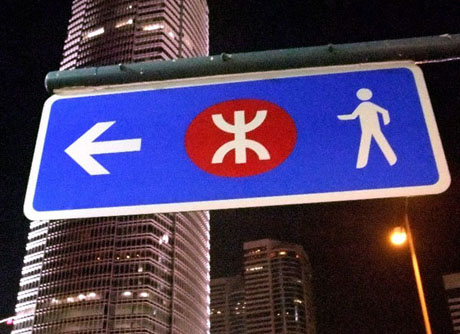
Direction sign to MTR Station
Stations and trains are spotlessly clean, well lit and safe and trains frequent and reliable. Most station platforms are served by escalators and lifts and many stations are now equipped with platform safety doors under an ongoing upgrade programme. In March 2012, MTR announced that 13 stations are to be equipped with new lifts between concourse and street level, with four being completed by the end of 2012 and the remainder by mid 2016. As at mid-2014, of the 83 MTR stations operating daily 75 stations had lifts serving the station concourse. Of the remaining eight stations, lifts are expected to have been installed at Prince Edward, Admiralty, Sai Wan Ho, Yau Ma Tei and Shau Kei Wan within two years. At Diamond Hill lifts are to be installed in tandem with works for the Sha Tin to Central Link, at Fortress Hill it is planned that government owned external lifts (connecting street level with the top of the hill) will be extended down to the station concourse but at Tin Hau no suitable location for retrofitting of a lift has yet been identified.
Station platforms and concourses are ventilated and air-conditioned with temperatures being kept at 27C and 29C respectively.
Entry to station platform is via barriers which are operated by single-journey ticket, Octopus Card or various MTR passes such as One-Day Tourist Pass or Airport Express Travel Pass.
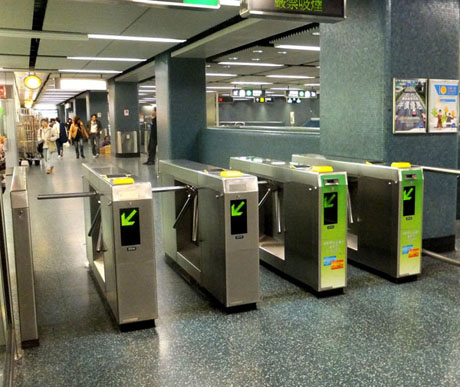
Station platform entry barriers operated by single-journey ticket, Octopus Card or various types of MTR pass
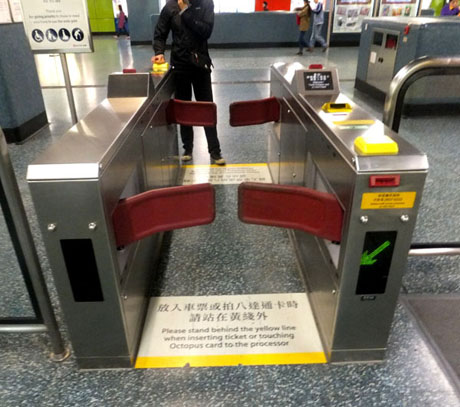
Wide barrier for passengers with luggage or special needs
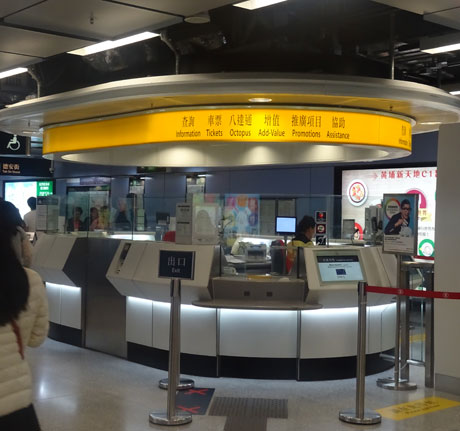
Customer Service Centres on the concourses of most stations (but not some South Island Line stations) deal with enquiries, sell tickets and Octopus Cards and provide Octopus add-value service
Several stations have free internet access via terminals at iCentres in the concourse. However, from July 2013 free wi-fi hotspots will be available at the paid areas of all MTR stations, but not on platforms or trains. Each wi-fi session is limited to 15 minutes and a maximum of 5 sessions per day.
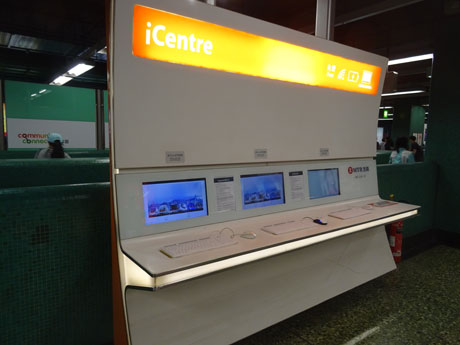
iCentre providing free Internet access at Sham Shui Po Station
Transferring between interconnecting lines is usually fast and simple and at many stations simply involves walking a few metres to an adjacent platform. Some subways at interconnecting stations East Tsim Sha Tsui/Tsim Sha Tsui stations and Central/Hong Kong Stations are equipped with moving walkways.
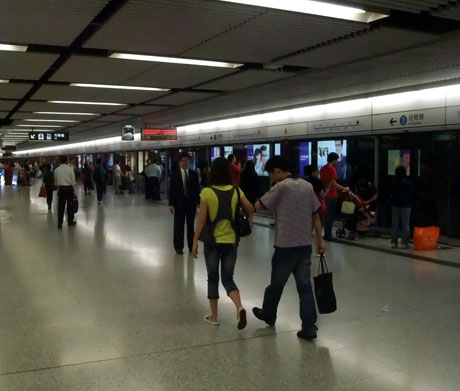
MTR Central Station Island Line platform
Many stations are equipped with toilet facilities at concourse or platform level and all those without toilet facilities have public toilets within 200-metres of at least one station exit. For a detailed list of stations with toilets and the location of those with nearby facilities see;
http://www.mtr.com.hk/en/customer/services/nearbytoilet.html
At stations not equipped with public toilets, MTR staff have been instructed to allow passengers to use staff toilets on request. Public toilets have also been built by MTRCL at public transport interchanges connected to four stations on the Tsuen Kwan O Line and public toilets will be provided within, or adjacent to, stations of new lines and extensions in future. Since 2008 MTRCL has been undergoing its "In Touch With Nature" refurbishment programme for the East Rail (former KCR) line which will see refurbishment of all stations on the line by 2016 using an architectural theme with earth-toned materials in warm and natural colours. Tai Po Market was the first station to be completed and work at Mongkok East Station was also completed during 2010. Refurbishment work at Shatin, Fanling and Sheung Shui stations had been completed by mid-2013. The whole refurbishment programme is expected to cost about HK$4 billion.
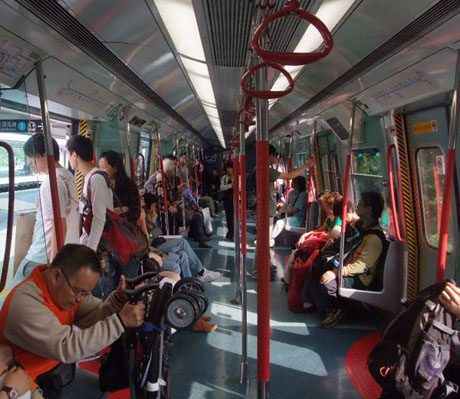
MTR train interior
Train seats are rather austere, polished steel benches and standing is commonplace. Eating, drinking and smoking are not allowed in trains or on platforms. In July 2010 MTR began a programme of replacing some seats on Island Line trains with wall-mounted supports for standing passengers to create more standing room and space for passengers with wheelchairs, luggage and baby strollers. Trains on the Tsuen Wan, Kwun Tong and Tsueng Kwan O lines will also be refitted in due course.
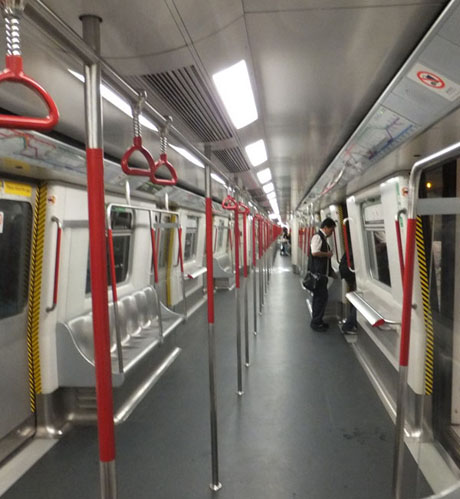
Since mid-2010, commencing with Island Line trains, MTR has begun creating more luggage space by removing some seats and replacing with wall-mounted supports (see right of picture) for standing passengers
Mobile phone signals can be received throughout the whole system and 4G technology was introduced at the busiest stations from late-2012 and was available throughout the whole network by mid-2013.
Platform screen doors were retro-fitted to platforms at all above-ground and open stations by the end of 2011, with the exception of East Rail and Ma On Shan lines, where it was not considered viable owing to curved platforms at stations on these lines. However, platform screen doors were planned to be installed at the 22 stations on these lines during construction of the new Sha Tin to Central Link Line. The programme for retro-fitting platform screen doors was funded by a ten cent levy on all journeys taken using Octopus Card which commenced in 2000 and ended in December 2013, two years ahead of the original date. Outstanding work is being funded from MTR’s internal resources. Automatic platform gates were installed at Racecourse Station on East Rail Line during August 2023 with installation of screen doors at the remaining 12 East Rail stations expected to be completed by the end of 2025. The project involves 35 platforms and 1600 pairs of gates. Train stopping positions at East Rail stations will be adjusted to minimise platform gaps pending installation of platform gates at other East Rail stations. Installation of platform screen doors at Fanling Station began in late February 2024 with Lo Wu, University and Mong Kok East stations to follow in the fourth quarter of 2024. In May 2025 the installation of platform screen doors at Mong Kok East Station on East Rail Line completed the programme to install gates at all MTR heavy rail stations.
In October 2016 MTR began testing of new signalling systems which will be phased in across the network over a 10-year period, commencing with East Rail Line. The work is being carried out overnight during non-service hours and is expected to boost network capacity by 10% by allowing trains to operate at increased frequency.
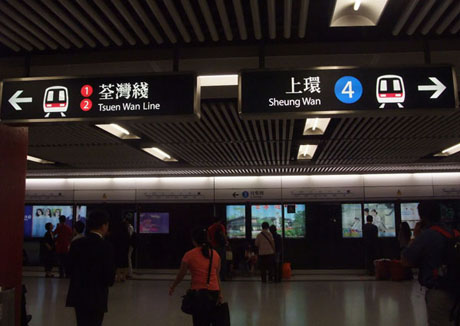
Directions to lines and platforms within MTR interchange stations are clearly signed
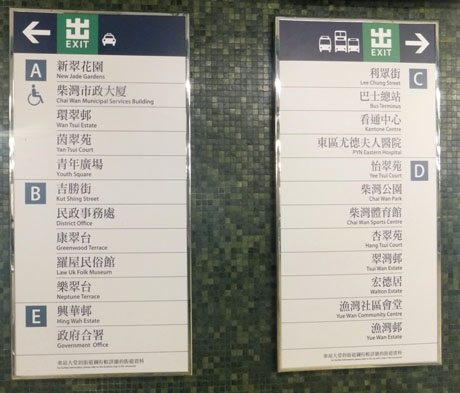
Information boards indicate which exits are nearest to local buildings and attractions
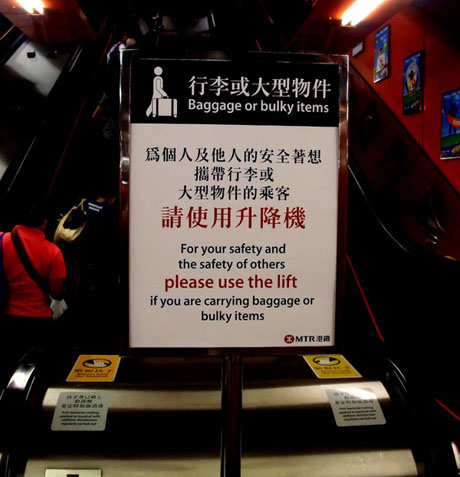
Luggage is allowed on the MTR but, for safety reasons, passengers are requested to use the lifts (where available) rather than escalators
Since 2008 MTR Corporation has brought into service 22 new trains and renovated 69 existing trains internally to make boarding and disembarking easier and also make trains easier for disabled passengers to use. New internal and external colour schemes have been introduced with white, green and purple replacing silver, red and blue. The additional trains were to acquired to cope with the increase in passengers following opening in August 2009 of the Kowloon Southern Link which connects East Rail and West Rail. In November 2008 MTR placed its first order with a mainland Chinese company, Changchun Railway Vehicles, for ten new trains costing HK$1.1 billion to be delivered in 2011/2012 to improve frequency on the Island, Kwun Tong, Tsuen Wan and Tseung Kwan O lines. Four of the new trains underwent testing on the Kwun Tong Line from October 2011 with the first new train being introduced into service on 7th December 2011. By March 2012 five new trains were in service enabling 370 additional journeys a week and increased service frequencies on the Tsuen Wan Line at peak times and on the Tseung Wan, Kwun Tong and Island Lines at weekends. The new trains have LCD screens in each compartment to provide audio-visual infotainment, CCTV cameras and improved ventilation. Floors, designed to reduce noise from under the train, and rubber seals fitted around door frames ensure quieter journeys. In March 2015 announced that it was planning to spend about HK$7 billion to refurbish or replace 78 trains used on the Kwun Tong Line, Tsuen Wan Line, Island Line and Tseung Kwan O Line. The tendering process was completed by the end of April 2015 and a final decision on whether to replace or refurbish is expected to be made in July or August 2015 after the four tenders have been evaluated. The trains are part of the fleet of 98 first generation trains manufactured by UK based Metro-Cammell, most of which 83 were introduced in 1979, 15 in 1989, all of which were refurbished in 2000.
In July 2015 announced it had awarded a HK$6 billion contract to Chinese manufacturer CSR Qingdao Sifang Co Ltd for 93 new 8-car trains to replace all its first generation UK-built trains operating on the Kwun Tong, Tsuen Wan, Island and Tsueng Kwan O lines, which have been in service for about 30 years. The trains will be delivered between 2018 and 2023 and will incorporate new features including an improved lighting system designed to make trains feel more spacious, dynamic route maps, double branched handrails throughout the carriages to better meet the needs of standing passengers and more comfortable straphangers.
After final integration of the MTR/KCR networks was completed in September 2008 interchange barriers at Kowloon Tong, Nam Cheong and Mei Foo were removed enabling passengers seamless interchange between MTR and former KCR lines.
In November 2009, in a bid to improve caring and courteous behaviour, MTR introduced a pilot scheme for priority seats on the Kwun Tong, Island, East Rail, West Rail, Tsuen Kwan O, Ma On Shan and Tung Chung Lines. One pair of seats located near the doors in selected carriages of trains on each of these lines are designated Priority Seats with the intention that these be offered to people in need such as elderly, pregnant, handicapped or injured. During the first month of the pilot MTR Ambassadors on board trains rewarded passengers who offer their seats to others with free single-journey tickets.
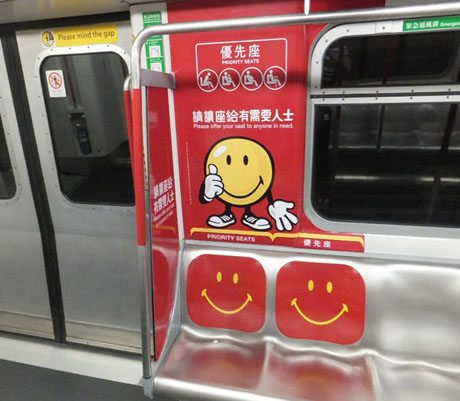
Priority Seats for the needy have been a feature of MTR trains since November 2009
MTR fares increased by an average of 2.05% from 13th June 2010, the first fare increase in 13 years. However, journeys on Airport Express Line, journeys to the border stations of Lo Wu and Lok Ma Chau which commence from stations south of MTR East Rail Tai Wai Station and MTR cross-boundary Inter-City services were excluded from the increase. A further fare increase of 2.2% which saw most fares rise by ten or twenty cents per journey was implemented on 13th June 2011.
From 17th June 2012, a fare increase, averaging 5.4%, the maximum allowed under the government's fare adjustment mechanism based on a formula which combines the consumer price index and transport wage rises, took effect. Single-journey fares under HK$7 and Airport Express fares were not adjusted at June 2012. Single-journey ticket fare adjustments are made in units 50 cents (MTR Ticket Issuing Machines accept coins in denominations of 50 cents, 1 dollar, 2 dollars, 5 dollars and 10 dollars). Single-journey fares under HK$7 were not increased as it was considered the percentage increase would be disproportionate, with the result that there were 596 journeys (representing about 2% of a total of all fare combinations and mainly child and senior concessionary fares), where single-journey fares were lower than Octopus Card fares by between 10 cents and 40 cents.
Following a five-yearly review of the fare adjustment mechanism (FAM) by the government, MTR fares were further increased by 2.7% overall from 30th June 2013, which is less than the 3.2% increase which would have applied under the original adjustment formula. Under the new formula agreed between the government and MTR, a more objective and transparent methodology is used to calculate the value of the Productivity Factor in the FAM formula. About 73% of fares will increase by no more than 20 cents and about 2% of fares remain unchanged.
To mitigate the fare adjustments MTR Corporation is offering a new package of concessions including a new MTR City Saver ticket scheme, from no later than 2nd quarter 2014, whereby a HK$400 pass will enable passengers to bulk purchase 40 MTR journeys within 30 days within a pre-designated urban area. The "10% Same-Day Second-Trip Discount" promotion, which had been due to expire 30th June 2013 was extended to 31st March 2014.
A further fare increase averaging 3.6% is to take effect from 29th June 2014. The rise has again been calculated in accordance with the government's revised Fare Adjustment Mechanism. The fare increase will be the fifth consecutive year in which fares have risen. MTR made a net profit of HK$13 billion for the year ended December 2013 and will allocate HK$152.5 million to reinstate the 10% same day second journey discount scheme from June 2014, which includes payment of a HK$27.5 million fine for service disruptions in 2013 and HK$125 million which the company is required to share with passengers from HK$8.6 billion "underlying profits". The same day second journey 10% discount which expired on 31st March 2014 will be reinstated from 29th June 2014 and will continue until 30th April 2015.
In March 2015 MTR announced an overall fare adjustment of +4.3% from 21st June 2015. Fares for 41% of all passenger journeys will rise by 10 or 20 cents, for 25.4% of all passenger journeys the increase will be 30 or 40 cents, 11.9% of journeys will increase by 50 cents and 19.2 % by over 50 cents. 2.5% of fares will remain unchanged. MTR will offer a package of promotions during 2015/16 including a "10% Same-Day Second-Trip Octopus Discount" which will run from 21st June to 30th November 2015 and "MTR Festive Discount" which will operate on six designated days during Christmas 2015, Lunar New Year 2016 and Easter 2016 when Adult Octopus Card holders will be able to travel at Child Octopus concessionary fares. Other concessionary Octopus Card holders will pay a flat fare of HK$1 per journey on these days but the promotion excludes Airport Express, journeys commencing or terminating at Lo Wu or Lok Ma Chau Station, first-class travel on East Rail Line and MTR Feeder Bus journeys. Other promotions include a one year extension of the "MTR City Saver" which was introduced in June 2014 and is aimed at frequent travellers taking medium and long distance cross-harbour journeys and a one year extension of the "Early Bird Discount Promotion" introduced in September 2014 which encourages passengers to use the MTR outside the morning peak period by offering a 25% discount to Adult Octopus Card holders when exiting from 29 core urban stations between 7-15am and 8-15am on Monday to Friday (except during holidays).
In March 2016 the government requested MTR to bring forward a review of its fare adjustment mechanism by one year to 2017 following public concern over MTR's profitability and passenger affordability. Following the review it was announced in March 2017 that the existing fare adjustment mechanism will be maintained but that concessions, valued at about HK$587 million a year, will be offered to Octopus Card users for at least the first six months of each year for five years. Passengers will get a 3% fare refund for every trip paid by Octopus Card during this period, replacing the 10% second trip discount which has previously applied. There will also be a 30 cents discount for passengers switching between the MTR network and over 500 green minibus routes.
MTR fares will rise by an overall average of 2.65% from Sunday 26th June 2016. The increase has been calculated in accordance with the government's Fare Adjustment Mechanism (FAM) and will see 78% of fares adjusted upwards by 30 cents or less, of which 4% will remain unchanged, and no fare will increase by more than 50 cents.
From 1st July 2016 all 32 MTR Octopus Fare Saver machines installed throughout Hong Kong will offer a HK$2 discount for the next trip at designated MTR stations. Currently 17 machines offer a $2 discount and 15 offer HK$1 discount.
The "10% Same-Day Second-Trip Discount" promotion which has previously operated at various periods between 2013 and 2015 will operate again for about four months from 26th June 2016 until 31st October 2016.
The existing "Early Bird Discount Promotion" will be extended for a further year to 31st May 2017 and both the "MTR City Saver" and "Monthly Pass Extra" promotions are being extended for one year to 30th June 2017. A HK$50 MTR Shops Cash Coupon will be given to all passengers who purchase any July or August "Monthly Pass Extra" in 2016 or any "MTR City Saver" during these two months.
A new fare promotion "Designated Saturday Offer" will operate on the first Saturday of each month for the five months from November 2016 to March 2017 and will allow Adult Octopus Card holders to travel at concessionary fares equal to Child Octopus fares and concessionary Octopus holders will be able to travel at a flat fare of HK$1 per journey (except Airport Express, MTR Feeder Bus, journeys to or from Lo Wu and Lok Ma Chau stations and East Rail Line First Class travel).
Owing to "fare rounding" following fare adjustments, whereby single-journey ticket fares are priced in increments of 50 cents and Octopus fares are priced in increments of 20 cents there have, until recently, been a number of journeys where Octopus fares are more expensive than single-journey ticket fares. Following the June 2014 fare adjustment these have been eliminated apart from a small number of Light Rail single-journey ticket fares and the latest chart detailing these journeys and fares, effective from 26th June 2016 can be found at this link;
http://www.mtr.com.hk/archive/en/tickets/SJT_cheaper2016_psd_en.pdf
MTR fares will not increase during the year commencing June 2017 and, for a period of about six months, Octopus Card users will receive a 3% discount on all MTR journeys.
In 2012 MTR revised its policy on service suspension during adverse weather conditions. All above ground train services will be suspended when a No 9 typhoon signal or higher is hoisted. Services at all stations on East Rail Line, Ma On Shan Line, Tung Chung Line, Disneyland Resort Line and Airport Express Line is suspended. Some stretches of the Tsuen Wan Line, Kwun Tong Line, Island Line and West Rail Line, Light Rail and MTR buses will also be suspended.
In August 2014 MTR announced a major upgrade to Hung Hom Station which is to become a major interchange station on completion of the Shatin to Central Link, currently under construction and due for completion in 2018. Two new platform levels will be built as well as mid-level walkway between concourse and platform levels directly connected to the concourse by lifts and escalators to improve connectivity for passengers travelling between the station and the Cross-Harbour Tunnel Plaza, Hung Hom district and Tsim Sha Tsui. Work commenced in September 2014.
In September 2014 seven new major rail projects, commencing from 2020 at a total estimated cost of about HK$110 billion, were announced by the Hong Kong Government. The projects are the Northern Link and Kwu Tung Station, the Tuen Mun South Extension, the East Kowloon Line, the Tung Chung West Extension, Hung Shui Kiu Station, the South Island Line (West) and the North Island Line.
From early January 2016 an extra carriage was added to existing 7-carriage trains operating on West Rail Line. The enhancement has increased the capacity of the line by 14% which will help to accommodate the increase in passengers expected when the Shatin to Central Link opens in 2019.
In November 2016 MTR announced that its fleet of fifteen 4-car trains operating on the Ma On Shan Line will be replaced by 8-car trains over a period of about twelve months commencing early 2017. The increased capacity is in preparation for development of the East West Corridor of the Shatin to Central Link project where a direct train service will run from Wu Kai Sha, the eastern terminus of the Ma On Shan Line, through the West Rail Line to Tuen Mun, targeted for completion in 2019.
The MTR South Island Line (East) opened for service on Wednesday 28th December 2016. Completion was originally expected in 2015 but difficulties encountered with excavation works in the vicinity of Admiralty Station delayed the opening. The line has been built at an estimated cost of HK$16.9 billion with about half the cost being met by the government. The 7km line runs from Admiralty Station to Ap Lei Chau via a tunnel to Nam Fung Road in Aberdeen then along a 2km elevated viaduct from Aberdeen Tunnel Toll Plaza via Wong Chuk Hang and across the Aberdeen Channel to Lei Tung Estate on Ap Lei Chau. The line is a "medium-capacity" system capable of carrying up to 20,000 passengers per hour in each direction and will serve both residents of the south side of Hong Kong Island and tourists travelling from existing and future attractions. It is also hoped that the new line will help relieve congestion at the Aberdeen Tunnel by encouraging passengers to transfer from road to rail. The line is fully automated and operates with driverless trains. MTR has purchased ten 3-carriage trains for the line at a cost of HK$540 million from Changchun Railway Vehicles Company, a subsidiary of China CNR Corporation. Admiralty Station will be an interchange station with the Tsuen Wan Line for cross-harbour destinations and there will be four other stations on the line at Ocean Park, Wong Chuk Hang, Lei Tung Estate (Ap Lei Chau) and South Horizons (Ap Lei Chau). Trains will operate at about 3-minute frequency and journey times will take 12 minutes from South Horizons to Admiralty, 6 minutes from Ocean Park to Admiralty and 14 minutes from Ocean Park to Tsim Sha Tsui (with interchange at Admiralty). The line is expected to carry about 170,000 passengers a day. Wong Chuk Hang, Lei Tung and South Horizons stations do not have customer service centres and "Mobile Service Mode" has been adopted at these stations. A mobile service team will rove around the stations to provide timely and proactive information for passengers. There will also be self-service information points for ticketing issues, purchase of single-journey tickets, adding value to Octopus Cards and contacting staff through a video conferencing facility and information counters in the unpaid areas of these stations provide information on station facilities and MTR routes via tablets integrated into the counters.
In September 2018 MTR introduced MTR Ticket and Octopus Selling Machines at Airport Station enabling passengers to purchase Airport Express tickets and On-Loan Standard Octopus Cards with credit cards and other mobile payment devices.
In December 2018 it was announced that AlipayHK has won a bid to provide a QR code mobile payment platform for the MTR system. Passengers will be able to link their AlipayHK account to an MTR app and scan a smartphone QR code at platform entry gates. Users of the mainland Alipay wallets will also be able to link their accounts to the Alipay app. The system is expected to have been rolled out to all MTR stations by mid-2020. Alipay will have an exclusive right to operate the QR system for one year to 2021 after which three further, so far unnamed, providers will also provide QR payment services. The QR system will provide an alternative to the Octopus Card payment system, which will continue to operate.
In March 2019 MTR Corporation has announced that under the Government's Fare Adjustment Mechanism (FAM) the fare adjustment for the period of 12 months from 1st June 2019 results in a fare increase of 3.3%. However, MTR has confirmed its commitment to the fare rebate scheme whereby passengers paying fares by Octopus Card will receive a rebate of 3.3% on each Octopus trip, initially until the end of 2019 but subsequently extended to a period of 40 weeks from 1st June 2019. Therefore there will be no fare increase for Octopus passengers before March 2020. This concession was subsequently extended to the end of 2020 by MTR as part of special relief measures resulting from the COVID-19 virus outbreak and in June 2020 MTR announced that the 3.3% rebate would be increased to 20% rebate on every Octopus trip from 1st July 2020 until the end of 2020.
In December 2020 MTR confirmed that the 20% Octopus rebate scheme would be extended by a further three months to 31st March 2021. Under the annual fare adjustment mechanism for 2021 overall fares reduce by 1.85% with effect from 26th June 2021, the first reduction since the mechanism was introduced by the government in 2009. The "20% Rebate for Every Octopus Trip" promotion which ran from July 2020 to the end of March 2021 is replaced by a "5% Rebate for Every Octopus Trip" from 1st April to 26th June 2021 and 3.8% rebate from 27th June 2021 to 1st January 2022.
The Fare Adjustment Mechanism for year end 2021 amounted to +0.5% and again resulted in no fare increase for 2022/23. In March 2022 MTR confirmed that the 3.8% Octopus trip rebate would be extended to 1st January 2023.
The Fare Adjustment Mechanism for the year ended 2022 resulted in an overall adjustment rate increase of 2.3%.with over 90% of fares having an upward
adjustment of 40 cents or less. Individual MTR, Light Rail and MTR Bus fares are adjusted with the weighted average adjustment of all fares combined
equaling the overall fare adjustment rate. Whilst over 90% of fares have
an adjustment of 40 cents or less, about 75% of fares increase by 20 cents or less (amongst which 4% will remain unchanged), while about 18% of
fares will have an increase of 30 to 40 cents. The fare adjustment takes effect from Sunday 25th June 2023.
The MTR Tuen Ma Line Phase 1 commenced services on 14th February 2020, connecting Kowloon East to the existing Ma On Shan Line through Lion Rock. The new line includes two new stations, Hin Keng and Kai Tak, as well as the expansion of Diamond Hill Station which becomes an interchange station with the Kwun Tong Line. In addition to providing linkage between the New Territories East and Kowloon East, the line extends railway service to new communities in the Kai Tak redevelopment area. Trains operate at a frequency of about 3.5 minutes and the journey time for the full length of the line is about 20 minutes. The line fully opened on 27th June 2021 with the opening of new stations at To Kwa Wan and Sung Wong Toi and became the longest MTR line at 57km enabling direct train services from Tuen Mun in the New Territories West to Wu Kai Sha at Ma On Shan in New Territories East with 27 stations and 6 interconnecting stations and incorporating the former West Rail Line. Construction began in June 2012 and the new line will form part of the HK$99.1 billion Shatin to Central Link expected to commence passenger services with the final section of the link from Admiralty to Central due for completion in the first quarter of 2022.
In April 2020 MTR announced that beginning from the middle of the year over an 18 month period all existing 12-car East Rail trains would be replaced by 9-car sets with the first batch comprising 8 out of a total of 37 sets. The rollout is necessary to allow trains to conform with new platform designs for stations on the Sha Tin - Central Link due for completion in 2022 and MTR has given an assurance that the shorter trains will not lead to passenger congestion and will increase train frequency as appropriate. The first 9-car trains were expected to enter service on 12th September 2020 but their introduction was delayed until 8th February 2021 owing to last minute signalling problems.The number of 9-car sets will gradually increase over a period of time and 12-car trains will still operate at peak periods.
From 23rd January 2021 MTR in conjunction with AlipayHK will introduce a new QR code payment system for all of its heavy rail network except the Airport Express Line. Passengers will be able to travel with QR code simply by binding AlipayHK to MTR Mobile and using “My Ticket” on the MTR app, or using “EasyGo” on AlipayHK. There will be at least two entry/exit gates accepting QR code payment at every gateline at all 93 heavy rail stations (except Airport Express stations) and they will be wrapped with prominent purple stickers. There will also be signage at stations facilitating passengers to identify the relevant gates. From 20th February 2022 UnionPay App and WeChat Pay were added to the MTR QR code ticketing service.
On 27th November 2022 MTR introduced the first 8-car set of 93 new trains sets commissioned to replace first generation trains dating back to 1979 on the Kwun Tong Line. Manufactured by CRRC Qingdao Sifang Corporation, the newly acquired Q-Trains cost over HK$6 billion to replace the over 40-year-old British M-Trains and will also be gradually introduced in sequence to the Tsuen Wan Line, Island Line and Tseung Kwan O Line by 2029. Enhancements include draught screens near train doors being moved slightly towards the middle of train compartments to allow more space for passengers to board and alight from the trains more smoothly, more handrails including grab poles with split pole design and straphangers, more comfortable seats with an ergonomic design and backrest added, dynamic route maps providing more train service information, full LED lighting which makes train compartments brighter and more environmentally friendly and “Smart servers” on trains which enable real-time remote monitoring of critical components during train operations, and big data analysis for enhanced preventive maintenance.
In March 2023 MTR announced it is to invest over HK$1.3 billion to upgrade its automatic fare collection system by replacing entry/exit gates at all stations with new gates which will support contactless credit card payment. The contactless credit card payment facility is expected to be in place by the end of 2023 at the earliest. MTR has subsequently accepted contactless Visa card payment since December 2023 and Mastercard and UnionPay from 24th August 2024, except for Airport Express journeys. Each station on the MTR network is currently equipped with at least two light blue coloured entry/exit gates which accept contactless payment. Airport Express entry/exit gates are expected to be upgraded to accept contactless payment during 2026 at the earliest. All MTR customer service centres accept contactless payment.
In June 2023 an application by MTR Corp to trial non-passenger hydrogen trains in Tuen Mun was agreed in principle by the authorities with a commencement date for trials expected to be the second half of 2024. Other applicants to the project are Sinopec (HK) who proposeto build a hydrogen fueling station in
Au Tau, Yuen Long and Linde HKO who plan to power the trains with hydrogen
using hydrogen tube trailers – trucks that carry long tubes that contain
compressed hydrogen.
In January 2024 MTR confirmed that following a review its existing protocol of suspending open section train services in the event of typhhon signal 9 or higher being raised will continue.
New eight-car trains entered service on the Island Line from 28th January 2024, replacing the existing first-generation trains which are reaching the end of their life. The Island Line is the second urban line with new trains operating following the Kwun Tong Line. The train renewal project for urban lines is the largest investment in rolling stock for MTR so far. The project was approved in 2015, purchasing 93 new trains for urban lines at HKD6 billion at the time. Thitreen new eight-car trains for urban lines have been in service on the Kwun Tong Line since late November 2022.
In February 2024 MTR it intends to implement a six-month trial of hydrogen powered trains on its Light Rail system to assess regulatory compliance and safety requirements. Following trials with one hydrogen unit it was reported in December 2024 that problems with incompatibility between the low-floor trains and existing light rail platforms may result in MTR dropping its plans to introduce hydrogen powered trains.
In March 2024 MTR announced that the Fare Adjustement Rate for the year commencing June 2024 is capped at 3.09% overall. Changes to individual fares and effective date will be annoiunced at a later date.
In April 2024 MTR Corp announced an asset renewal programme for the Disneyland Resort Line which will see new signalling and the introduction of new trains to replace the existing three four-car sets in 2028.
All MTR stations are covered by 5G and upgrade work is taking place to enhance the network to 5G “Golden Spectrum” by installing 3.3 and 3.5 GHz indoor base stationsto provide a faster and smoother service and enable digital advertising formats that can feature live stream and interactive advertisements as well as AI games for real-time interaction between passengers and brand. As at late June 2025 upgrade to 5G “Golden Spectrum” had been completed at 8 stations (Hong Kong, Kowloon, Central, Admiralty, Wan Chai, Causeway Bay, Tin Hau and Tsim Sha Tsui) and upgrades at a further 16 stations (North Point, Quarry Bay, Yau Ma Tei, Prince Edward, Cheung Sha Wan, Lai Chi Kok, Mei Foo, Lai King, Tsing Yi, Kowloon Tong, Lok Fu, Wong Tai Sin, Diamond Hill, Lam Tin, Yau Tong, Tiu Keng Leng) were due for completion between 2025 and 2027.
In April 2025 MTR Corp confirmed it had applied for increases amounting to about 9.5% on Airport Express services. The last increase took effect in June 2017. MTR is planning to invest more than HK$2 billion to renew Airport Express facilities including constructing a new platform to connect the airport station with Terminal Two, as well as upgrading ticket gates and ordering new trains. Airport Express has been facing financial challenges since the number of tourists has declined during the coronavirus pandemic with its passenger numbers only returning to about 70% of pre-Covid levels. Hong Kong's inflation rate has risen by 13.8% between 2017 and 2024 and energy costs rose by 27% over the same period. It is expected that the increases will take effect from June 2025.
JOURNEY PLANNING
Fares are inexpensive and full details of fares, routes and journey times are available from the MTR Journey Planner;
http://www.mtr.com.hk/en/customer/jp/index.php
In addition, MTR has four apps available for mobile devices;
The popular “MTR MOBILE” app, originally launched in October 2010, jpurney planner with fare information, has since been enhanced from June 2012 with a search function for point-to-point first and last train information and location of barrier-free facilities. A full revamp to create an even better user interface of this app is to be carried out in late 2012.
“NEXT TRAIN”, launched 14th June 2012, provides real-time information on the next four trains arriving at a specified station on the Tung Chung, Airport Express. West Rail and Tseung Kwan O Lines
“MTR TOURIST” (Discontinued mid-2016) launched 14th June 2012, assists visitors in navigating around the MTR system by providing a journey planner with relevant information such as routing, interchange stations, platform numbers and the exit nearest to the intended destination or tourist attraction. The app also includes a point to point visitor attraction search, Tourist Ticket information, details of Airport Express Shuttle Bus services, Intercity service information and travel tips.
MTR “TRAFFIC NEWS”, (Discontinued mid-2016) launched September 2012, provides information during serious train service disruptions. It includes notification of train service suspensions or serious disruptions of 20 minutes or more, information on train service when Typhoon Signal No. 8 or above is issued, notices related to overnight train services during special festive days, e.g. New Year’s Eve overnight service and a search function for Rail Service Suspension –Passenger Guide.
In the Hong Kong SAR Chief Executive's Policy Address on 12th October 2011 it was announced that Hong Kong residents age 65 and over and people with disabilities will be able to make journeys on public transport, including MTR, for a maximum fare of HK$2 per ride when using Octopus Card. The scheme, which benefits some 1.1 million people is being introduced in phases, with the first phase of the scheme, applicable to MTR journeys became operational on 28th June 2012. Under the terms of the "Public Transport Fare Concession Scheme for the Elderly and Eligible Persons with Disabilities", the government reimburses transport companies for lost revenue. Prior to the introduction of this scheme, holders of the Elder Octopus Card were eligible for maximum HK$2 fare for MTR journeys taken on Wednesdays, Saturdays and public holidays in addition to normal concessionary fares on other days.
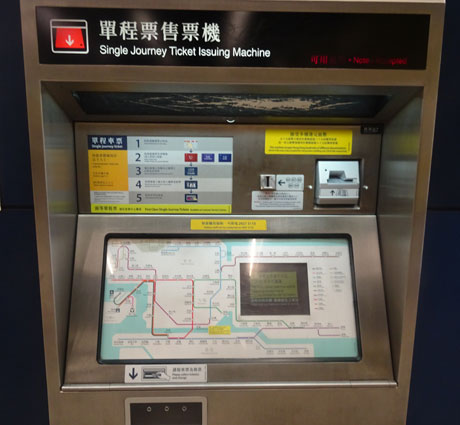
MTR Single-journey ticket machine. Machines accept coins but not notes. With a few exceptions single journey ticket fares are more expensive than journeys made using Octopus Card
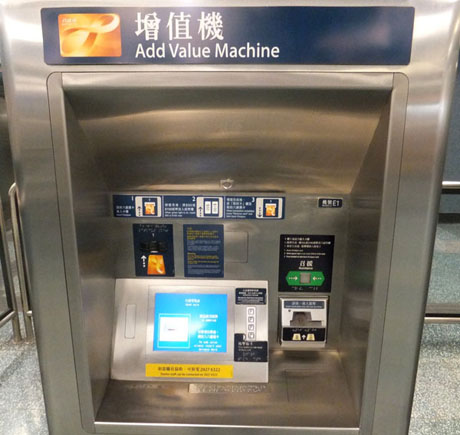
Add-Value machine for "topping-up" Octopus Card credit
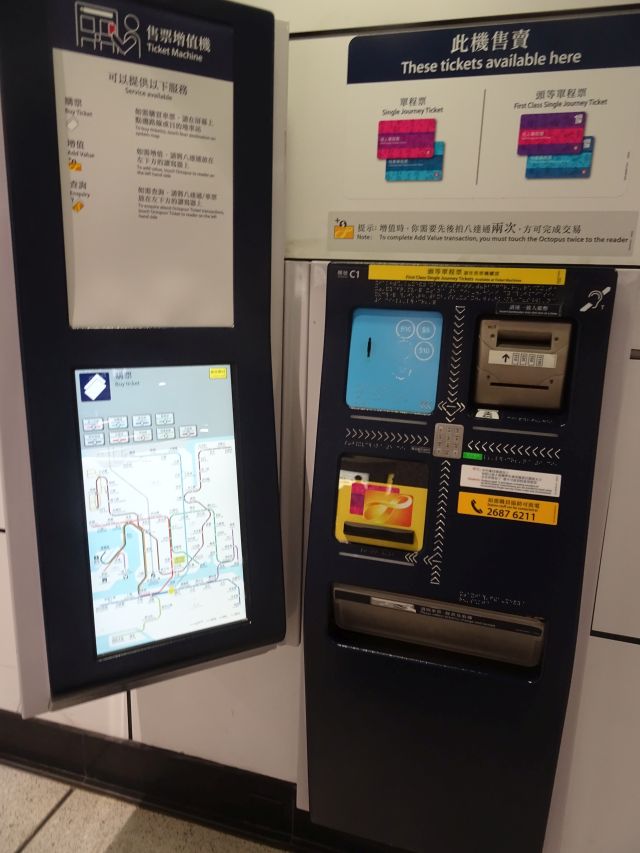
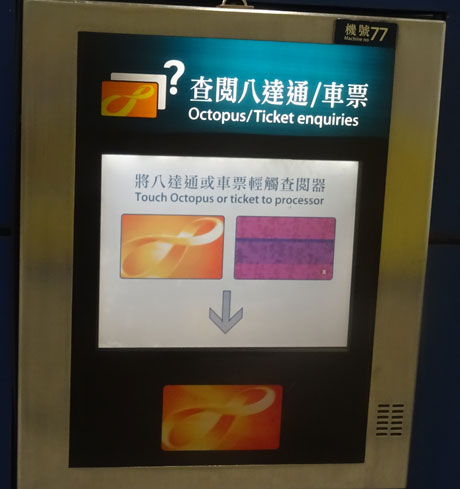
Recent transactions and Octopus balance can be checked at Octopus Card / Ticket Enquiry Machines
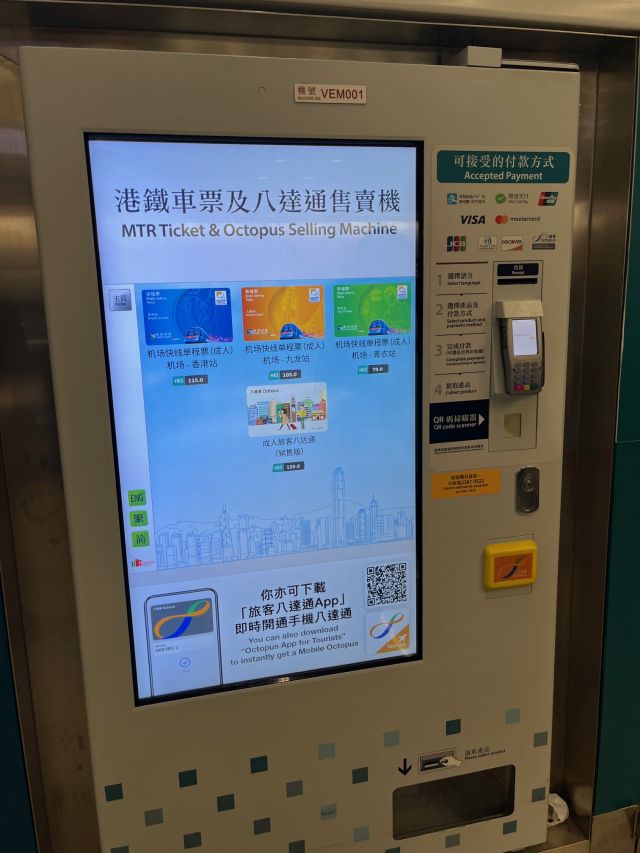
MTR Ticket and Octopus Selling Machines were introduced at Airport Station in September 2018 enabling passengers to purchase Airport Express tickets and Tourist Octopus Cards with credit cards and other mobile payment devices. On-Loan Octopus Cards are, however, no longer available from these machines
In March 2023 MTR announced it is to invest over HK$1.3 billion to upgrade its automatic fare collection system by replacing entry/exit gates at all stations with new gates which will support contactless credit card payment. The contactless credit card payment facility is expected to be in place by the end of 2023 at the earliest.
MTR Corporation will accept contactless payment with “China T-Union Card” for MTR rides from 22 March 2025 as an additional fare payment option for visitors to Hong Kong. The MTR automatic fare collection system currently accepts Octopus, QR code tickets, contactless bank cards and physical and electronic Single Journey Tickets. The newly added “China T-Union Card” is an integrated card for taking public transport across over 300 mainland cities. The card is marked with a “China T-Union” logo. Each MTR station in the heavy rail network (except Airport Express stations) will be equipped with at least two entry/exit gates providing “China T-Union Card” payment service. Gates supporting the new function will have the “China T-Union” logo on display and passengers can tap “China T-Union Cards” at the Octopus readers at these gates for entry and exit. Fares for passengers paying with “China T-Union Card” will be the same fares as Adult Octopus. Fares will be deducted from the Renminbi (RMB) stored value in the card and settled in Hong Kong dollars converted by Octopus readers. Before entering the gates at MTR stations. Passengers must ensure the balance of their “China T-Union Card” is over RMB50. Top-up service in Renminbi is not available in MTR stations. The card cannot be used for First Class trips on East Rail Line and is not valid on MTR Light Rail and MTR Bus.
For further information see;
https://www.mtr.com.hk/en/customer/tickets/about_t_union.html
xxxxxxxxxxxxxxxxxxxxxxxxxxxxxxxxxxxxxxxxxxxxxxxxxxxxxxxxxxxxxxxxxxxxxxxxxxxxxxxxxxxxxxxxxxxxxxxxxxxxxxxxxxxxxxxxxx
MTR OCTOPUS FARE SAVER;
MTR Fare Saver machines are intended to reward people who choose to walk to certain designated MTR stations rather than take buses or taxis. As at June 2016 there are 32 MTR Fare Saver machines strategically located a few hundred metres from the nearest MTR station which allow Adult Octopus Card holders a discount of HK$2 or HK$1 on their next journey from the designated station provided the journey is made on the same day. However, from 1st July 2016 the discount will become HK$2 from all machines. Simply "swipe" the Octopus Card over the reader to take advantage of this discount.
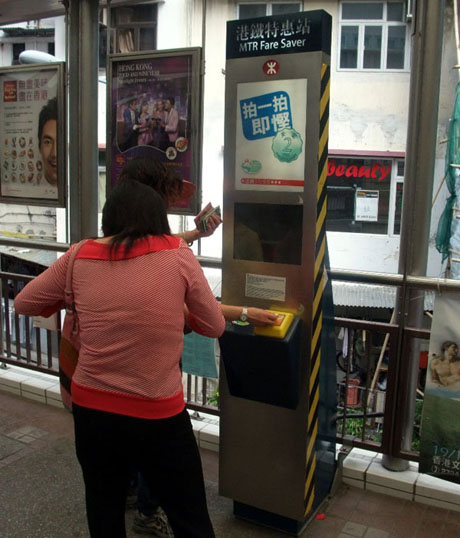
MTR Fare Saver machine located above Hollywood Road on the Central - Mid-levels Escalator System
Current list of locations of machines, designated MTR Stations and amount of discount is available here;
http://www.mtr.com.hk/en/customer/tickets/fare_saver.html
During November 2010 MTR installed about 40 portable life-saving defibrillators at 10 of its busiest stations under a trial scheme. During that period defibrillators were used three times and in October 2011 MTR decided to equip all 84 MTR stations with defibrillators. The 237 defibrillators, which cost a total of HK$3.5 million, are available at customer service centres or platform booths and MTR's 750 managers have been trained by the Fire Services Department in cardio pulmonary resuscitation and the use of defibrillators.
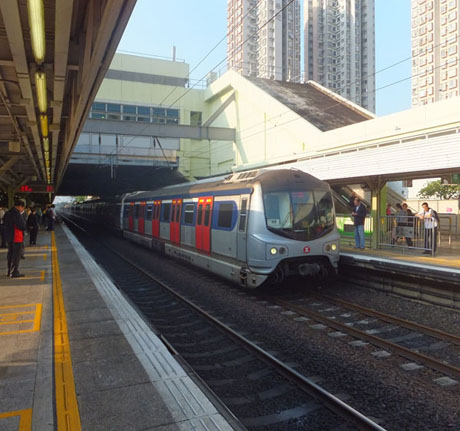
MTR train arriving at Tai Po Market Station on East Rail Line
AIRPORT EXPRESS
The Airport Express operates with a fleet of 11 trains over a 35.3km line from Hong Kong Station on Hong Kong Island via Kowloon, Tsing Yi and Hong Kong International Airport stations to Asia World-Expo Station which is just a short distance beyond the airport. It provides a fast dedicated service to and from the airport and carries an average of about 48,000 passengers daily during 2018 of which about one-third were business travellers. However, strict entry requirements to Hong Kong during the COVID-19 pandemic since 2019 and dearth of tourist had a dramatic impact on Airport Express passenger numbers which declined to about 6,000 daily in 2021 but by the end of 2024 had recovered to about 36,000. Tsing Yi and Kowloon Stations are interchange stations for the MTR network. Hong Kong Station is also served by the Tung Chung Line and is connected to MTR Central Station by subway and moving walkways. Journey times to/from the airport are;
Tsing Yi Station 12 minutes
Kowloon Station 20 minutes
Hong Kong Station 24 minutes
From the airport to Asia World-Expo is an additional 4 minutes journey time.
Trains to/from the airport operate daily every 10 minutes from 05-50 until midnight and every 12 minutes from midnight until close of service at 00-48.
In January 2024 MTR announced it had commenced designing new Airport Express trains to replace the existing 25-year old fleet.
For more information regarding Airport Express see TO/FROM AIRPORT
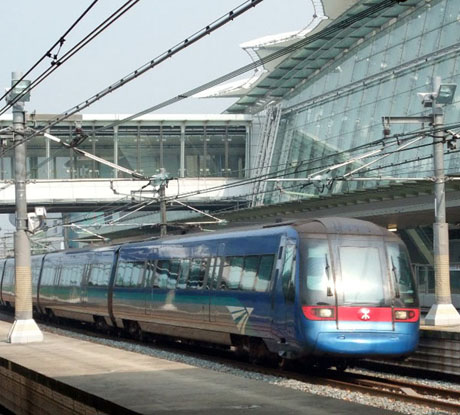
Airport Express Train passing through Sunny Bay Station
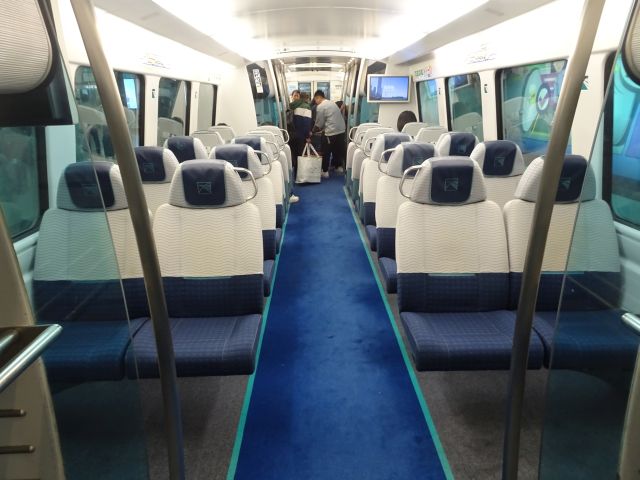
Airport Express train interior
MTR LIGHT RAIL
The MTR Light Rail system was commissioned in September 1988 and formerly operated by KCR until December 2007.
Modern electric “streetcars” operate frequent services along twelve interconnecting lines serving 36.15kms and 68 stations in the New Towns and suburbs of Yuen Long, Tin Shui Wai, Yuen Long and Tuen Mun in the western New Territories. Some of the stations are interchange stations with MTR West Rail. The current fleet of train cars numbers 140, having been increased from 119 in 2008 with the phasing in of an additional 22 LRV's costing HK$400 million between 2009 and 2010 in order to meet additional demand after following commissioning of the Kowloon Southern Link in September 2009 and population growth in the New Territories. The new trains incorporate CCTV surveillance and a new internal and external livery which is being extended to the existing fleet. The 69 first-generation LRV's were refurbished to improve comfort and capacity in a programme which was completed in 2011. MTR Light Rail operates about 2,800 services a day with each train able to carry up to 250 passengers. The average daily patronage at the end of 2024 is about 423,500. The system is supported by a fleet of 116 MTR feeder buses. From April 2014 the Light Rail service was strengthened with an additional 148 journeys a day, mainly between Tin Shui Wai and Tuen Mun, which increased the daily passenger capacity of the system to about 720,000. In July 2016 MTR announced it had placed an order with CRRC Nanjing Puzhen Co Ltd for 40 new Light Rail Vehicles at a cost of about HK$745 million. These vehicles will replace 30 Japanese-built second generation vehicles which have been in service since 1992 and expand the fleet size by an additional 10 vehicles to 150 by 2023, with a phased introduction of the new vehicles into service from 2019. The new vehicles will have an improved LED lighting system to improve ambience of the train saloons, additional passenger seats and improved handrails and strap hangers. The first two vehicles were delivered on 28th December 2018 before undergoing testing and commissioning procedures and safety and performance tests and obtaining government approval before being introduced into public service. The remaining 38 vehicles were to be delivered in batches between 2019 and 2023. The last of the second generation vehicles was withdrawn from service on 26th February 2023.
The Light Rail System is easy to use. Fare payment can be made either by Octopus Card or by individual journey ticket which can be obtained from ticket machines on the platform. The system is based on honesty and there are no entry or exit barriers at stations. Passengers simply walk onto the platform and either validate Octopus Card or buy a ticket from a ticket machine. On disembarking at the destination station the Octopus Card must be "touched" on one of the card readers on the platform to ensure the correct fare is deducted.
Owing to "fare rounding" when fares are increased, whereby Octopus fares are calculated in increments of 20 cents and Single-Journey Ticket fares are calculated in increments of 50 cents, a small number of Single-Journey Ticket fares are lower than Octopus fares. Details of these journeys and fares following the June 2014 fare adjustment can be found at this link;
http://www.mtr.com.hk/archive/en/tickets/SJT_cheaper2014_psd_eng.pdf
In February 2024 MTR announced its intention to implement a six-month trial of hydrogen powered trains on its Light Rail system to assess regulatory compliance and safety requirements. The first hydrogen light rail train was delivered in June 2024 to the Tuen Mun depot for testing and inspections before commencement of trials during non operating hours.
From May 2025 MTR will begin a two month "Cat/Dog Carrying Trial Scheme" on the Light Rail network whereby passengers will be allowed to carry pets subject to purchasing a "Cat/Dog Carrying Pass"and complying with conditions as the cat/dog being carried in an enclosed carrier or backpack and only boarding at the last carriage of the train. For details see;
https://www.mtr.com.hk/archive/corporate/en/press_release/JPR-2025-3-25-E.pdf
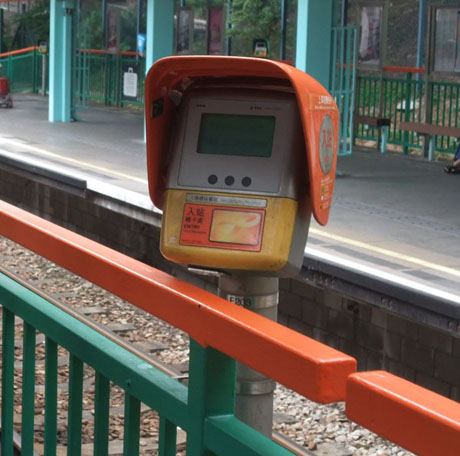
Light Rail Octopus platform entry fare processor
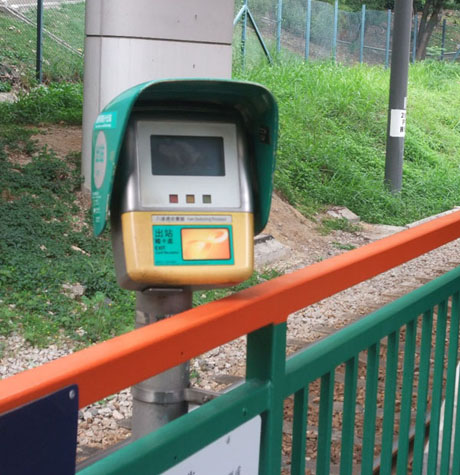
Light Rail Octopus platform exit fare processor
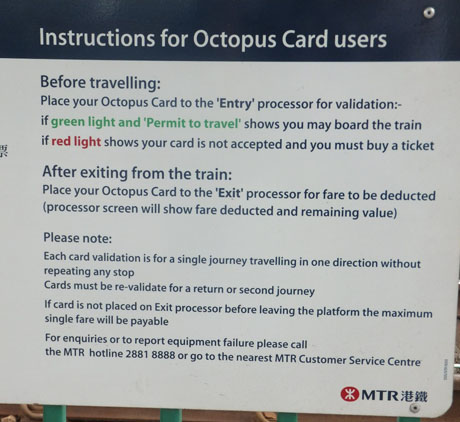
Light Rail instruction notice for Octopus Card users
Fares are structured by zone, there being five zones. Spot ticket checks are carried out by MTR revenue protection staff and hefty fines can be imposed for non payment. Detailed route maps are displayed on all station platforms. Services operate from approx 05-30 to 01-00.
For full schedules see;
http://www.mtr.com.hk/en/customer/services/schedule_index.html
For a detailed map of the Light Rail system see;
http://www.mtr.com.hk/en/customer/services/light_rail_fare.php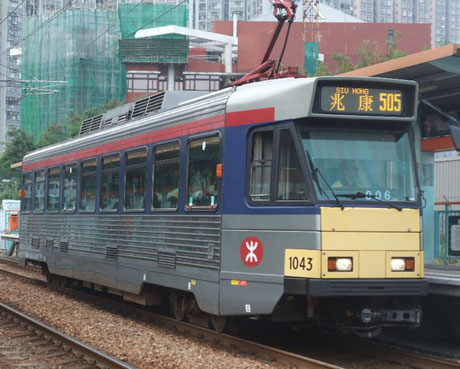
First generation single-car Light Rail unit at Ching Chung Station, Tuen Mun. Many services are also operated by two-car units
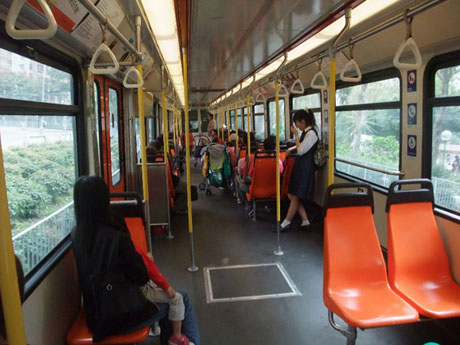
Interior of first-generation Light Rail car
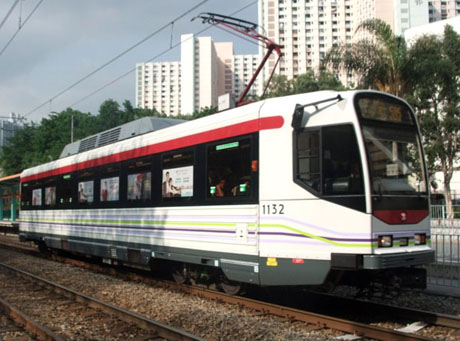
Second generation Light Rail car in new livery, seen leaving Lam Tei Station
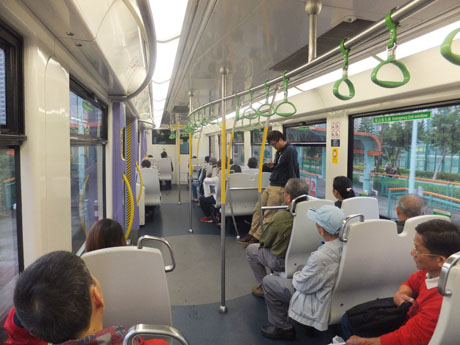
Interior of second-generation Light Rail car
MTR Light Rail also operates some feeder bus services mainly in the North West New Territories along routes serving Light Rail and West Rail.
MTR INTERCITY PASSENGER SERVICES (KTT) - SUSPENDED SINCE JANUARY 2020 - PERMANENTLY CEASED OPERATION
Since 2007, MTR, in conjunction with the Chinese mainland authorities, has operated cross border Intercity through passenger services which had formerly been operated by KCR since 1998. These services, known as the Guangzhou - Kowloon Through Train (KTT), start from the terminus at Hung Hom in Kowloon. Hung Hom Station is also served by MTR East Rail. The Intercity cross-border service has, however, been suspended since January 2020 owing to the Covid-19 pandemic and MTR has indicated the service may be terminated permanently since passengers numbers have declined substantially since commencement of Express Rail high-speed service. In August 2024 the General Administration of Customs of China announced the
closure of four intercity train ports in Beijing, Shanghai, Guangzhou
and Dongguan thereby formally confirming permanent closure of the Intercity Through Train service.
There were twelve daily services from Hung Hom to Guangzhou East of which ten called at Dongguang with a journey time of approx 1 hour 40 minutes. One service called at Foshan and terminated at Zhaoqing, a journey time of around 4 hours.
There were also trains to and from Beijing West (journey time 24 hours) and Shanghai (journey time 20 hours) on alternate days.
Hong Kong Immigration formalities were completed at Hung Hom Station (not at the border).
For full timetable, fares, ticketing and online ticket purchase see;
http://www.it3.mtr.com.hk/B2C/frmIndex.asp?strLang=Eng
In June 2012 CSR Sifang, a subsidiary of China's leading train manufacturer, China South Locomotive and Rolling Stock Corporation Limited, was awarded a contract to supply 50 new T-class carriages for the KTT which began being introduced into service in 2013. The carriages comprise 40 cushioned-seat carriages, five combined cushioned-seat and luggage carriages and five dining cars. Additionally, in order to increase capacity on the service, a ninth carriage was added to existing eight carriage sets.
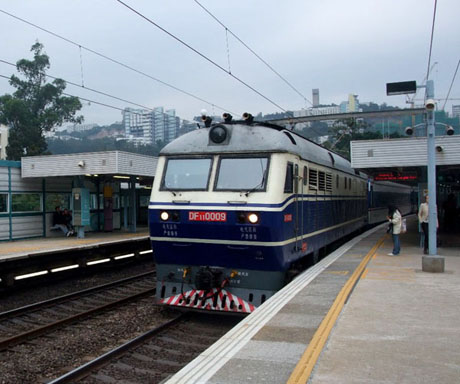
Guangzhou - Hong Kong Intercity Express passing through University Station
From 15th June 2024 the previous Inter City Through Train services between Hung Hom and Beijing and Hung Hom and Shanghai, which had been suspended since January 2020 were replaced by High Speed Rail sleeper services operating from Hong Kong West Kowloon Station. In August 2024 the General Administration of Customs of China announced the closure of four intercity train ports in Beijing, Shanghai, Guangzhou and Dongguan thereby formally confirming permanent closure of the Intercity Through Train service.
XXXXXXXXXXXXXXXXXXXXXXXXXXXXXXXXXXXXXXXXXXXXXXXXXXXXXXXXXXXXXXXXXXXXXXXXXXXXXXXXXXXXXXX
XXXXXXXXXXXXXXXXXXXXXXXXXXXXXXXXXXXXXXXXXXXXXXXXXXXXXXXXXXXXXXXXXXXXXXXXXXXXXXXXXXXXXXX
HIGH SPEED RAIL
GUANGZHOU - SHENZHEN - HONG KONG EXPRESS RAIL LINK (XRL) HIGH-SPEED RAIL -
The opening of XRL on 23rd September 2018 has connected Hong Kong with the 25,000 km Chinese national high-speed rail network allowing direct trains to 44 destinations. The 26km Hong Kong Section of the 142km XRL runs underground from the Hong Kong West Kowloon Station terminus to the mainland boundary at Huanggang where it connects with the national network. Constuction began on mid-2010 and the estimated cost of the project is about HK$84 billion. The service concession has been granted to MTR Corporation for a 10-year period. A joint immigration checkpoint has been established enabling passengers to complete both Hong Kong and Mainland entry/exit procedures at Hong Kong West Kowloon Station
The 44* destinations (increased to 66 from 1st April 2023 and 78 as at June 2024) that the direct XRL trains reach comprise six short-haul destinations, namely Futian, Shenzhen North, Guangmingcheng, Humen, Qingsheng and Guangzhou South of the Guangzhou-Shenzhen-Hong Kong Passenger Line, and 38 long-haul destinations along the Beijing-Guangzhou Passenger Line, the Hangzhou-Fuzhou-Shenzhen Passenger Line, the Shanghai-Kunming Passenger Line and the Guiyang-Guangzhou Passenger Line, including Beijing, Shanghai, Kunming, Guilin, Guiyang, Shijiazhuang, Zhengzhou, Wuhan, Changsha, Hangzhou, Nanchang, Fuzhou, Xiamen and Shantou.
* with effect from 10th July 2019 long-haul services additionally operate to Chongqing, Foshan, Tianjin and Zhaoqing.
There are 114 pairs of short-haul trains daily during peak periods (general holidays of Hong Kong and public holidays in the Mainland and the connecting weekends, summer holidays during July and August, and the Spring Festival travel seasons in the Mainland). On weekdays and weekends (Friday to Sunday), 70 and 82 train pairs run daily respectively. Subject to market demand, the train schedule will be suitably adjusted in view of passenger flow. There are also 13 pairs of direct long-haul trains daily. Nine sets of Hong Kong-owned trains are branded "Vibrant Express".
Journey times for long-haul services include 8h 56m to Beijing, 8h 17m to Shanghai, 6h 20m to Zhengzhou, 4h 33m to Wuhan 3h 12m to Changsha, 7h 38m to Kunming 10h 30m to Hangzhou and 3h 19m to Guilin.
Short-haul journey time to Guangzhou South is 47 minutes via non-stop services and between 51 and 71 minutes for stopping services. Journey time to Futian and Shenzhen North is 14 and 23 minutes respectively.
MTR High Speed Rail introduced overnight SLEEPER TRAIN services between Hong Kong West Kowloon Station, Beijing and Shanghai on Fridays to Mondays from 15th June 2024.
Train D910 to Beijing West departs Hong Kong West Kowloon at 18-24. Train D909 departs Beijing for Hong Kong West Kowloon at 20-13. Journey time is about 12 hours, 30 minutes.
Train D908 to Shanghai Hongqiao departs Hong Kong West Kowloon at 19-49, Train D907 departs Shanghai for Hong Kong West Kowloon at 2015. Journey time is about 11 hours.
Trains comprise sixteen cars, accommodating approximately 600 passengers. The train composition includes thirteen sleeper cars, one dining car, and two second class seating cars. Trains to and from Shanghai Hongqiao station also feature one premium sleeper car. The new High Speed service replace the MTR Inter-City Through Train sleeper services between Hung Hom Station in Kowloon and Beijing and Shanghai which operated from 2007 until the service was suspended in 2020 during the Covid-19 pandemic.
For further information see;
https://www.highspeed.mtr.com.hk/en/latest-news/SleeperTrain.html
For High Speed Rail timetable, fare and ticketing information see;
https://www.highspeed.mtr.com.hk/en/main/index.html
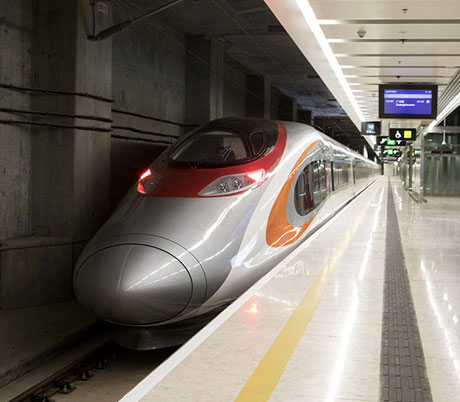
One of the nine Hong Kong based sets of "Vibrant Express" trains at Hong Kong West Kowloon Station
MTR announced that from 1st July 2025 High Speed Rail (Hong Kong Section) will serve seven additional stations along five routes expanding the number of mainland destinations directly accessible from Hong Kong West Kowloon Station to 96. Two of the additional stops are within Guangdong province, Enping Station in Jiangmen and Lechang East Station in Shaoguan. The other five stops provide intercity connections at Jingdezhen North in Jiangxi, Xianning North in Hubei, Luohe West in Henan, and Hunan's Furongzhen and Leiyang West stations.
From 23rd September 2018, the date of commencement of High Speed Rail operations, three new bus routes will provide services to/from West Kowloon Station Bus Terminus, namely Citybus route W1 (to/from Admiralty and Central), KMB route W2 (to/from Kwun Tong and Lam Tin) and KMB route W3 (to/from Sheung Shui, Tai Po and Sha Tin).
Citybus Route W1 (SERVICE PERMANENTLY CEASED OPERATION 19th JULY 2020) West Kowloon Station bound service operates from 05-45 to 21-45pm daily, departing from Admiralty Station (West) Bus Terminus, via Connaught Road Central near Statue Square and directly heading via the Western Habour Crossing for West Kowloon Station boarding and alighting area, before terminating at West Kowloon Station. Admiralty bound service operates from 07-30 to midnight daily, departing from West Kowloon Station, via West Kowloon Station boarding and alighting area and directly heading for Connaught Road Central near Jardine House, before terminating at Admiralty Station (West) Bus Terminus. The service will operate at 10-15 minute frequency. The full fare is HK$8.9.
KMB Route W2 circular service between Kwun Tong Station and Jordan via West Kowloon Station bound service operates daily from 06-25 to 20-25 at 30 minute frequency then at 21-25, via Lam Tin Station. The full fare is HK$6.1.
KMB Route W3 West Kowloon Station bound service operates from 05-00 to 22-40 daily, departing from Sheung Shui Bus Terminus via Kwong Fuk Estate, Sha Tin Station, Tsing Sha Highway Toll Plaza, West Kowloon Station boarding and alighting area, before terminating at West Kowloon Station. Sheung Shui bound service operates from 06-25 to 01-00 daily via the same route. The service will operate at 15-20 minute frequency. The full fare is HK$12.7.
Discounted (10%) round-trip tickets, valid 3 months from date of issue, can be purchased for routes W2 and W3 by using Octopus Card at the bus supervisor's offices at West Kowloon Station Bus Terminus, Lam Tin Station Bus Station and Sheung Shui Bus Terminus.